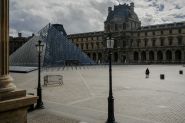The striking contrast between Paradise and Hell remains an inexhaustible source of artistic inspiration, where the promise of eternal redemption clashes with the ultimate desolation of darkness. In the first article of this series, we will explore, through three works, the night of infinite torments.
"Abandon hope, all ye who enter here." This ominous injunction adorns the gate of Hell in Dante Alighieri's Divine Comedy (1265-1321). It warns the souls about to cross the threshold of the Realm of darkness and eternal torment that all hope of redemption or deliverance will dissipate upon entry. Infinite desolation will immediately take its place, condemning them to a perpetual wandering among fallen shadows. In the Last Judgment, a fresco adorning the altar wall of the Sistine Chapel in Rome, Michelangelo depicts a terrifying scene where the damned are swept away by voracious and tormented demons in a chaotic whirlpool. Bodies writhe in a macabre dance, and the contrast between divine light and infernal darkness accentuates the irreversibility of their fall. In this abyss, the incandescent embers crackle with a horrifying noise. Icy. The crimson and orange flames of despair rise like relentless serpents, writhing and moving without respite, devouring everything in their path. The atmosphere is permeated with a pungent smell of sulfur, decay and regret. Souls are thus engulfed in a voracious, nightmarish and merciless twilight.
Several composers have sought to express, through music, the terror and desolation of Hell, depicting the eternal anguish of this fall into the realm of damnation. In this article, we will highlight three masterpieces: Franz Liszt's Fantasia quasi Sonata, Jacques Offenbach's Orphée aux Enfers and Camille Saint-Saëns' Danse macabre.
Scenes of Anguish
Unlike classical sonatas, which follow a structure of distinct movements, Liszt's Fantasia quasi Sonata is conceived as a continuous unit, though divided into two main sections. It was published in 1858 by Schott as the seventh and final piece of the second volume (Italy) of the Hungarian composer's Années de pèlerinage. Its final title, Après une lecture de Dante: Fantasia quasi Sonata, is inspired by Victor Hugo's almost eponymous poem, Après une lecture de Dante, from the collection Les Voix intérieures (1837). Liszt's choice of "du" instead of "de" seems intentional. It reflects the German practice of using the definite article to refer to a famous person, attempting to transpose this concept into French. The work begins with a dark and mysterious introduction, followed by a complex development incorporating various themes and bold modulations reflecting Liszt's Romantic aspirations. The opening motif recurs several times throughout the piece.
This first part is strongly marked by melancholy and introspection, reminiscent of the scenes of anguish and reflection on human destiny found in Dante's Inferno and Purgatorio. The second part, however, illustrates spiritual ascent and redemption, echoing the vision of Paradise in the Divine Comedy. The contrast between the two themes reflects the transition from darkness to light, a transition Dante explores in his journey through the different realms of the afterlife. Liszt addressed this same subject in his famous Dante Symphony (1857) dedicated to his friend and future son-in-law, Richard Wagner (1813-1883).
https://www.youtube.com/watch?v=fXxIeK3IjjE
Pursuit of Pleasure
Orphée aux Enfers is a two-act opéra bouffe by Offenbach, created in 1858. This work is a parody of the legend of Orpheus and Eurydice, introducing a satirical and humorous style to the classic mythological story. Orpheus, a poor violinist, and his wife Eurydice cordially despise each other. Tired of the monotony of her marriage, Eurydice attempts to seduce Aristée, who turns out to be Pluto, the lord of the underworld in disguise. He traps her and takes her to his dark infernal realm. "I leave the house because I am dead, Aristée is Pluto, and the devil takes me," Eurydice writes in her final message to Orpheus. While he secretly rejoices at his wife's death, whom he detests, Public Opinion reminds him to search for his wife even in the depths of Hell: "Come! Honor calls you!" The mythic couple's crisis quickly becomes contagious, leading to a revolt on Olympus and a decadence of the Underworld. By ridiculing the sacred myth of Orpheus, Offenbach, with caustic satir, critiques the hypocrisy and relentless pursuit of pleasure of his time.
The Galop infernal, often known as the Can-can, is probably the most iconic music from this opéra bouffe.
https://www.youtube.com/watch?v=7TFbAWCQ4ug
Dance of Death
Saint-Saëns' Danse macabre is a symphonic poem composed in 1874 that evokes the dance of the dead, a popular theme in the Middle Ages symbolizing the fragility of life and the inevitability of death. The work begins with the sound of a detuned violin, representing Death itself, playing a sinister tune to awaken the dead from their graves. This introduction is followed by the entry of the xylophones, mimicking the sound of clashing bones. Strings and percussion gradually join in, evoking a procession of skeletons who begin to dance in a macabre frenzy. The waltz rhythm, in three beats, enhances the piece's both playful and sinister character, while variations in tempo and dynamics create mounting tension. The solo violin, playing in harmonics, adds a mournful and airy touch, like an echo of the dead's laughter swirling under the pale moonlight. Towards the end, the chimes of the clock signal the dawn, and the dance gradually fades, the dead returning to their graves. The Sabbath is over.
https://www.youtube.com/watch?v=ZDWMoJz8OYU
Read more




Comments